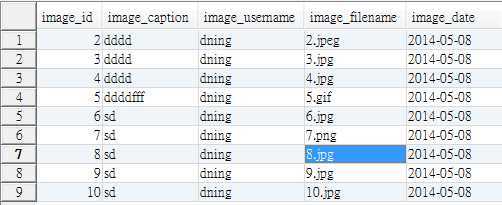php中上传图片
时间:2014-05-09 07:54:22
收藏:0
阅读:475
这里来看看php中如何上传图片的
先看代码check_image.php
<html> <head> <title></title> <style type="text/css"></style> </head> <body> <form action="check_image.php" method="post" enctype="multipart/form-data"> <table> <tr> <td>Your username</td> <td><input type="text" name="username" /></td> </tr> <tr> <td>Upload image*</td> <td><input type="file" name="uploadfile"/></td> </tr> <tr> <td colspan="2"> <small><em> * Acceptable image formats include: GIF, JPG/JPEG and PNG.</em></small> </td> </tr> <tr> <td>Image Caption</td> <td><input type="text" name="caption"/></td> </tr> <tr> <td colspan="2" style="text-align:center;"> <input type="submit" name="submit" value="Upload" /> </td> </tr> </table> </form> </body> </html>
这里没什么可以说的,都是常见的html标签。
下面看看上传的代码check_image.php,重要的地方都做了注释,整个过程是先根据那个<input type="file" name="uploadfile"/>指定的图片路径来创建一个图片文件,然后再通过指定的上传路径生成这个图片。
<?php $db = mysql_connect(‘localhost‘,‘root‘,‘Ctrip07185419‘) or die(‘can not connect to database‘); mysql_select_db(‘moviesite‘,$db) or die(mysql_error($db)); //上传文件的路径 $dir = ‘D:\Serious\phpdev\test\images‘; /* $_FILES:用在当需要上传二进制文件的地方,获得该文件的相关信息 $_FILES[‘userfile‘][‘name‘] 客户端机器文件的原名称。 $_FILES[‘userfile‘][‘type‘] 文件的 MIME 类型,需要浏览器提供该信息的支持,例如“image/gif” $_FILES[‘userfile‘][‘size‘] 已上传文件的大小,单位为字节 $_FILES[‘userfile‘][‘tmp_name‘] 文件被上传后在服务端储存的临时文件名,注意不要写成了$_FILES[‘userfile‘][‘temp_name‘]很容易写错的,虽然tmp就是代表临时的意思,但是这里用的缩写 $_FILES[‘userfile‘][‘error‘] 和该文件上传相关的错误代码。[‘error‘] */ if($_FILES[‘uploadfile‘][‘error‘] != UPLOAD_ERR_OK) { switch($_FILES[‘uploadfile‘][‘error‘]) { case UPLOAD_ERR_INI_SIZE: //其值为 1,上传的文件超过了 php.ini 中 upload_max_filesize 选项限制的值 die(‘The upload file exceeds the upload_max_filesize directive in php.ini‘); break; case UPLOAD_ERR_FORM_SIZE: //其值为 2,上传文件的大小超过了 HTML 表单中 MAX_FILE_SIZE 选项指定的值 die(‘The uploaded file exceeds the MAX_FILE_SIZE directive that was specified in the HTML form.‘); break; case UPLOAD_ERR_PARTIAL: //其值为 3,文件只有部分被上传 die(‘The uploaded file was only partially uploaded.‘); break; case UPLOAD_ERR_NO_FILE: //其值为 4,没有文件被上传 die(‘No file was uploaded.‘); break; case UPLOAD_ERR_NO_TMP_DIR: //其值为 6,找不到临时文件夹 die(‘The server is missing a temporary folder.‘); break; case UPLOAD_ERR_CANT_WRITE: //其值为 7,文件写入失败 die(‘The server failed to write the uploaded file to disk.‘); break; case UPLOAD_ERR_EXTENSION: //其他异常 die(‘File upload stopped by extension.‘); break; } } $image_caption = $_POST[‘caption‘]; $image_username = $_POST[‘username‘]; $image_date = date(‘Y-m-D‘); /*getimagesize方法返回一个数组, $width : 索引 0 包含图像宽度的像素值, $height : 索引 1 包含图像高度的像素值, $type : 索引 2 是图像类型的标记: 1 = GIF,2 = JPG, 3 = PNG, 4 = SWF, 5 = PSD, 6 = BMP, 7 = TIFF(intel byte order),8 = TIFF(motorola byte order), 9 = JPC,10 = JP2,11 = JPX,12 = JB2,13 = SWC,14 = IFF,15 = WBMP,16 = XBM, $attr : 索引 3 是文本字符串,内容为“height="yyy" width="xxx"”,可直接用于 IMG 标记 */ list($width,$height,$type,$attr) = getimagesize($_FILES[‘uploadfile‘][‘tmp_name‘]); //imagecreatefromgXXX方法从一个url路径中创建一个新的图片 switch($type) { case IMAGETYPE_GIF: $image = imagecreatefromgif($_FILES[‘uploadfile‘][‘tmp_name‘]) or die(‘The file you upload was not supported filetype‘); $ext = ‘.gif‘; break; case IMAGETYPE_JPEG: $image = imagecreatefromjpeg($_FILES[‘uploadfile‘][‘tmp_name‘]) or die(‘The file you upload was not supported filetype‘); $ext = ‘.jpg‘; break; case IMAGETYPE_PNG: $image = imagecreatefrompng($_FILES[‘uploadfile‘][‘tmp_name‘]) or die(‘The file you upload was not supported filetype‘); $ext = ‘.png‘; break; default : die(‘The file you uploaded was not a supported filetype.‘); } $query = ‘insert into images(image_caption,image_username,image_date) values ("‘.$image_caption.‘","‘.$image_username.‘",now())‘; mysql_query($query , $db) or die(mysql_error($db)); $last_id = mysql_insert_id(); //用写入的id作为图片的名字,避免同名的文件存放在同一目录中 $imagename = $last_id.$ext; $query = ‘update images set image_filename="‘.$imagename.‘" where image_id=‘.$last_id; mysql_query($query , $db) or die(mysql_error($db)); //有url指定的图片创建图片并保存到指定目录 switch($type) { case IMAGETYPE_GIF: imagegif($image,$dir.‘/‘.$imagename); break; case IMAGETYPE_JPEG: imagejpeg($image,$dir.‘/‘.$imagename); break; case IMAGETYPE_PNG: imagepng($image,$dir.‘/‘.$imagename); break; } //销毁由url生成的图片 imagedestroy($image); ?> <html> <head> <title></title> </head> <body> <h1>So how does it feel to be famous</h1> <p>Here is the picture you just upload to servers</p> <img src="images/<?php echo $imagename;?>" alt="upload image" /> <table> <tr> <td>Image save as:</td><td><?php echo $imagename?></td> <td>Image type:</td><td><?php echo $ext?></td> <td>Height:</td><td><?php echo $height?></td> <td>Width:</td><td><?php echo $width?></td> <td>Upload date:</td><td><?php echo $image_date?></td> </tr> </table> </body> </html>
最后写道数据库中的信息如下:

评论(0)

